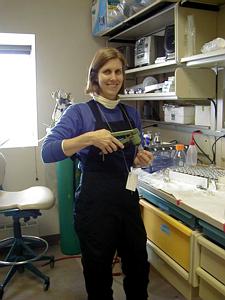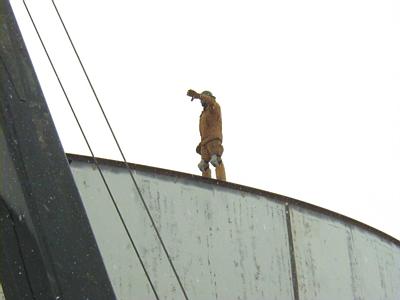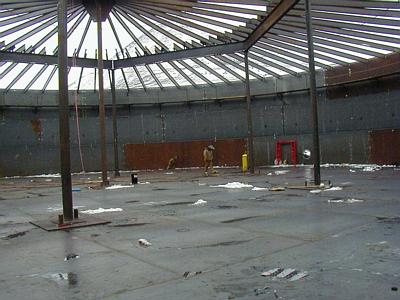23 November, 1999
McMurdo Station, Ross Island, Antarctica Tuesday
"There is always one unexpected little moment in life when a door opens to
let the future in."
Graham Greene
Bess, Mark, and Julie FINALLY made it out to East Lake Bonney today! Now
our workload doubles! Not really! I think that we might phase out the
first experiments from West Lake Bonney so that we can concentrate our
efforts on the East lobe.
While the crew was in the field, Maite and I busied ourselves with several
mundane lab chores. I cleaned serum vials (the vials into which we put our
gas samples). After cleaning the vials, they are dried in an oven. One
milliliter of saturated potassium chloride (KCl) was added to each vial.
Okay, chemistry students, what does 'saturated' indicate? After adding the
KCl with a pipette, the serum vials were closed with rubber, gas-tight
stoppers. Aluminum seals were crimped onto the vials to keep the stopper in
place. All of you Bionetics folks reading these journals: remember the
thousands of serum vials that we stoppered and crimped? I thought all of
that was behind me!
In-between lab activities, I accompanied the welding crew, working on the
diesel fuel tanks, to their afternoon shift. They graciously allowed me to
enter the tanks and photograph them at their work. I have included their
photographs with this journal. These tanks represent about 6 weeks of work
and will hold thousands of gallons of liquid diesel fuel when finished. The
welders have begun to cover the tanks and soon their task will be complete.
The welders have come to Antarctica from two welding crews; one in
California and another in North Dakota. These wonderful men took me under
their wings when I knew no one in Christchurch, making sure that I always
had something to do!
When our crew returned at 6 p.m., they headed to supper and Maite and I
began to process samples. Maite's job was to filter the trace metal samples
in her clean room and I filtered the chlorophyll samples. This task took me
until 1 a.m., at which time, I still had almost 100 mL of sample #5 left!
Sample #5 came from deep within the lake and was packed with suspended
parcticles. Bess told me that I could filter the remaining sample tomorrow!
Thank goodness!
If you read yesterday's journal, you were made aware of the influence of
Mother Nature on activities in Antarctica. Finally getting your name on a
helo flight is a good first step, and yet being scheduled on a helo and
having good weather doesn't necessarily indicate that you will be on the
flight! Take, for example, a repairman scheduled to fly to the Dry Valleys
today. He arrived, with only minutes to spare, without his bunny boots. As
I have stated previously, safety is first on the minds of everyone in
Antarctica. Should the helicopter be grounded in a remote area, a person
not properly attired COMPLETELY in Extreme Cold Weather (ECW) gear, would
suffer greatly. The repairman was denied permission to fly. Not only did
he miss his helo flight, he became the subject of radio gossip! News
travels fast in this small community and ALL news is fair game for the radio
operators!
ANSWER TO YESTERDAY'S QUESTION: The thickest ice recorded in Antarctica was
in Wilkes Land and measured 4700 meters!
TODAY'S QUESTION: What is the coldest temperature ever recorded in
Antarctica? Where was this temperature recorded?
Sharon
JUST FOR KIDS!!!!! Julie, Bess, and Mark flew in a helicopter to East Lake
Bonney today to get more water samples for our experiments. While they were
gone, Maite and I prepared some things to run the experiments. Maite
bubbled nitrogen gas into 5 liters of water. I cleaned, stoppered, and
sealed the vial into which we put the gas for the gas chromatograph
experiment.
I also had the opportunity to visit with a group of men who are building
these really big tanks to store gasoline! The tanks will hold thousands of
gallons of gasoline! How much gasoline does your car hold? I took a lot of
pictures of them welding. When they weld, they are connecting two pieces of
metal with a metal seam so that nothing will leak out. Look at a can of
soup without the label. Can you find the weld? Their welds are just like
the soup can weld only much bigger and stronger.
Do you remember that safety is the most important thing in Antarctica?
Today, someone was not allowed to ride on a helicopter because he forgot his
warm bunny boots! This gentleman would have had very cold feet and he might
have gotten frostbite!
ANSWER TO YESTERDAY'S QUESTION: The thickest ice recorded in Antarctica was
in Wilkes Land and measured 4700 meters!
TODAY'S QUESTION: What is the coldest temperature ever recorded in
Antarctica? Where was this temperature recorded?
Sharon

Sharon putting the aluminum seals on the rubber-stoppered serum vials.

Johnnie directing the crane operator delivering a beam to the roof of the tank.

Brian making a weld on the floor of the tank.

A view of the inside of the diesel fuel tank. This tank will hold thousands of gallons of liquid fuel.
Contact the TEA in the field at
.
If you cannot connect through your browser, copy the
TEA's e-mail address in the "To:" line of
your favorite e-mail package.
|
